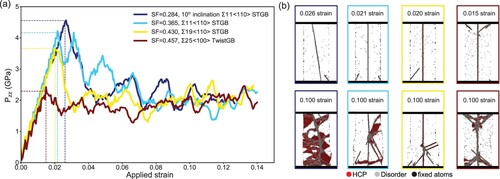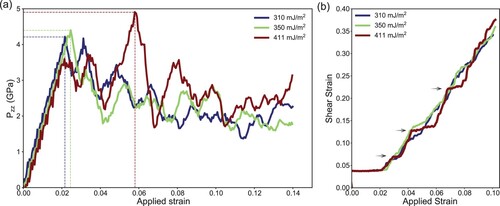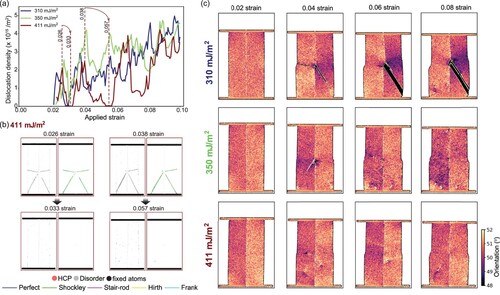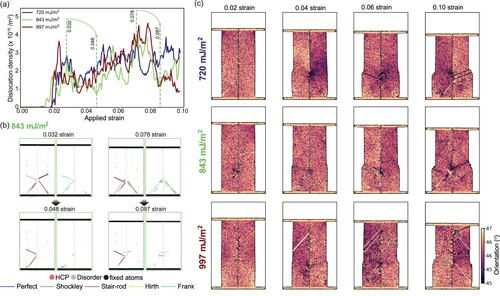 ?Mathematical formulae have been encoded as MathML and are displayed in this HTML version using MathJax in order to improve their display. Uncheck the box to turn MathJax off. This feature requires Javascript. Click on a formula to zoom.
?Mathematical formulae have been encoded as MathML and are displayed in this HTML version using MathJax in order to improve their display. Uncheck the box to turn MathJax off. This feature requires Javascript. Click on a formula to zoom.Abstract
This study investigated the high-strain rate deformation of bicrystal Cu nanopillars, using atomistic simulations. Nanopillars with minimum grain boundary energy were deformed to investigate the role of macroscopic degrees of freedom, finding that geometric parameters (Schmid factor) influence the stress–strain response. The deformation of metastable grain boundaries (GBs) revealed that in addition to geometric parameters, the response was also governed by the local atomic arrangement at the boundary, dictating the dislocation-GB interactions. These findings shed light on the response of nanopillars as a function of GBs and show the importance of both macroscopic and microscopic degrees of freedom on the mechanical response.
GRAPHICAL ABSTRACT

IMPACT STATEMENT
Metastable states, an often ignored aspect of GB structure, is shown to have a strong influence on dislocation-GB interactions; shedding new light on mechanical response of realistic GBs.
Introduction
Optimizing the microstructure to design materials with enhanced or desired properties has been a challenging area of research. Among the known microstructural defects, grain boundaries (GBs) and dislocations play a crucial role in controlling the mechanical response of polycrystalline materials [Citation1–5]. Depending on the macroscopic degrees of freedom, GBs can be classified into various types, such as tilt, twist, or mixed boundaries [Citation6,Citation7]. GBs can act as obstacles to dislocation motion, and the specific type of interaction between GBs and dislocations can be influenced by the atomic arrangement at GB and the type of interacting dislocation [Citation8–11]. These dislocation-GB interactions can result in dislocation pile-ups, absorption of dislocations, partial or full transmission, and dislocation emission or repulsion after absorption [Citation12,Citation13]. Consequently, numerous studies have been conducted to understand the role played by GBs in the overall deformation behaviour, with a specific emphasis on dislocation-GB interactions at the nano- to submicrometer scale [Citation14,Citation15]. In addition, it has been reported that GB relaxation, after annealing, leads to a significant increase in the hardness of nanocrystalline materials [Citation16–19].
Compression of nanopillars has been used to investigate plastic deformation mechanisms in single-crystal and polycrystalline samples [Citation20,Citation21]. These metallic nanopillars exhibited size-dependent flow strength, which differs from their bulk counterparts [Citation21]. However, limited studies have focused on bicrystal microstructures to understand the influence of individual GBs on crystal plasticity [Citation15,Citation22,Citation23]. For instance, a higher work-hardening rate was observed in an Al bicrystal due to dislocation pile-up, compared to single-crystal Al [Citation23]. Another study on bicrystal Al demonstrated that GBs operate as a sink for dislocations [Citation15]. These contradicting findings suggest that GB structure influences the plastic response in materials and motivated efforts to understand it through modelling. Tucker et al. [Citation24] examined three high-angle GBs to demonstrate that GBs can serve as either dislocation sinks (symmetric tilts) or sources (twist and mixed) in bicrystalline nanowires. Fensin et al. [Citation25] identified a direct correlation between GB type and void nucleation stress under shock deformation. Also, most modelling studies on nanopillar compression of bicrystals have focused on minimum energy GBs [Citation24,Citation26]. It is well known that real materials contain GBs with complex structures where the misorientation can change along the length of a GB [Citation27,Citation28]. Minimum energy GBs do not show this variability in GB structure. A better approach is to study the GB behaviour as a function of atomic arrangement by using both minimum energy and metastable structures. This allows one to investigate the crucial effect of these different GBs on the mechanical response of bicrystal nanopillars. In this study, the role of macroscopic (GB plane and its orientation with respect to the loading direction) and microscopic (metastability: local atomic arrangement at GB) degrees of freedom on the mechanical response of Cu bicrystal nanopillars was examined using molecular dynamics simulations.
Materials and methods
This work utilized Cu bicrystals with a GB at the centre for nanopillar compression. The pillars had a square cross-section with the GB positioned between the base and top (compression) slabs and spanning the distance between slabs, as depicted in Figure S1. Additional information is provided in the supplemental information (SI), section S2. Two simulation cell sizes were considered: nm3 (22.6 million atoms) and 25
25
50 nm3 (∼3 million atoms) to study size effects (see section S3 in SI). The equilibrium and metastable structures of
and
GBs with <110> symmetric tilt axes were considered. The (3,1,1) and (6,1,1) GB planes (of
and
GBs) were oriented normal to the X direction, and the compression was performed along the Z direction ([2,3,3] and [1,3,3]), as illustrated in Figure S1. The metastable structures were constructed by translating one grain relative to another within the GB plane and removing overlapping atoms at the interface. All simulations were performed (on 310 CPU ranks) using the open-source atomistic simulation software Large-scale Atomic/Molecular Massively Parallel Simulator (LAMMPS) [Citation29,Citation30], and the interaction between Cu atoms was represented using the EAM potential developed by Mishin et al. [Citation31]. The minimum energy
GB structure had a grain boundary energy (GBE) of 310 mJ/m2, whereas GBEs for metastable GBs were 350 and 411 mJ/m2. In contrast, GBE for the minimum energy
GB structure was 720 mJ/m2, and the GBE for metastable GBs was 843 mJ/m2 and 997 mJ/m2. For all metastable structures (Figure S4), GBs were parallel to the loading direction. However, for the minimum energy
GB, a simulation set-up with a 10o inclination along the Y direction was also considered. Additionally, for examining the role of macroscopic degrees of freedom a structure with
twist GB (<100> twist axis) was considered. Before loading, all nanopillars were equilibrated at 300 K for 120 ps using the Nosé-Hoover thermostat (NVT) with a 2 fs timestep. Shrink-wrapped (free) boundary conditions were applied in lateral directions, whereas for the loading direction (Z), a fixed boundary condition was applied. To study the size effects, pillars were compressed to 10-15% strain along the Z direction by moving the compression slab with a constant velocity of −0.5 Å/ps (strain-rate of ∼109 s-1). All other simulations were performed at a velocity of −0.07 Å/ps, i.e. a strain-rate of ∼108 s−1.
Result and discussion
After system size validation (see section S3 in SI), the small-sized nanopillar was selected as a representative system. To understand the role of macroscopic degrees of freedom, bicrystals with minimum energy and
GBs were deformed at a strain rate of 108 s−1. The stress–strain response for these nanopillars is shown in Figure (a). The stress in both cases peaks at a strain of 0.022; however, a higher yield stress of 4.2 GPa was measured for the
GB nanopillar compared to 3.8 GPa of the
GB nanopillar. The observed peak stress for these GBs are correlated with the Schmid factor for the primary slip system, 0.365 and 0.430 for
and
GBs, respectively. Higher Schmid factors for both the grain means easier activation of the slip system and hence, lower yield stress. Since these are symmetric tilt boundaries, the Schmid factor for both grains in a bicrystal nanopillar is identical. Consequently, the deformation in both grains is similar and commences simultaneously. Dislocations in both bicrystals nucleate at the bottom corners and travel toward the GB, as shown in Figure (b). The stress profile for
after yield point exhibited stick-slip behaviour, indicating periodic dislocation nucleation followed by absorption at the GB and/or free surfaces (after transmission across GB or reflection from GB). Importantly, the
nanopillar shows the formation of twins in one grain after 0.035 strain (discussed later). In contrast, the
nanopillar does not show the formation of twins and has a smoother variation in stress after the peak stress, indicative of continuous dislocation nucleation.
Figure 1. (a) Stress–strain response for equilibrium nanopillars at a strain rate of 108 s−1. Schmid factors (SF) for primary slip system of the grain with lowest SF among both grains are mentioned in the colour label. (b) Defects present in the bicrystals at the time of dislocation nucleation (top row) and 0.10 applied strain (bottom row). The coloured boxes around the images correspond to the colours of the stress–strain data in the panel (a).

This finding suggests that the variation in the peak stress for both nanopillars resulted from differences in their macroscopic degrees of freedom. The GB nanopillar with a high Schmid factor for both grains is easier to deform; thus, it exhibited lower yield stress. To validate the observed finding, two additional bicrystal nanopillars are studied. These include a
twist GB (<100> twist axis) with 0.457 Schmid factor in both the grains and a
GB with <110> symmetric tilt where the GB was at a 10o inclination with respect to the loading direction, as shown in Figure (b). The inclined nanopillar was considered to examine the role of different Schmid factors on deformation [Citation32]. In the case of inclined boundary, the Schmid factors for the grains changed to ∼0.28 and 0.43 for the primary slip systems as opposed to 0.365 when the boundary was normal to the loading direction. As discussed previously [Citation33], to satisfy strain compatibility, the overall mechanical response of bicrystals with mixed Schmid factors is governed by the grain with the lowest Schmid factor for the primary slip system as it will experience a higher stress concentration and should deform more readily to maintain compatibility between grains. Therefore, in this case, maximum deformation should be observed in the grain with the lowest Schmid factor for the primary slip system. Indeed, this behaviour was observed in the inclined –
GBs (see section S5 in the SI and Figure S5). A peak stress of 4.6 GPa was measured in the inclined –
at the strain of 0.03 (highest among all four cases). The nanopillar with the highest Schmid factor,
twist GB, showed the lowest peak stress of 2.6 GPa at a strain of 0.018 (lowest among all four cases). In summary, these differences in stress–strain response suggest that there is a first order influence of the Schmid factor on plastic deformation in a bicrystal regardless of the GB structure.
Additional simulations were also performed to understand the role of microscopic degrees of freedom on the mechanical response of Cu bicrystal nanopillars. This involved nanopillars with one minimum and two metastable structures for Σ11 and Σ19 symmetric tilt GBs. Figure (a) illustrates the stress–strain response of the Σ11 bicrystal nanopillars. In all three cases, the peak stress is observed at a strain of ∼0.022. Specifically, the 310 mJ/m2 and 350 mJ/m2 GBE pillars yielded at this strain, whereas for the 411 mJ/m2 GBE nanopillar, an additional peak in stress was observed at a strain of 0.058 strain. Furthermore, GBs with 310 and 350 mJ/m2 GBEs exhibit a similar stress-strain response after the yield point, which is different from the response of the 411 mJ/m2 GBE nanopillar.
Figure 2. (a) Stress–strain response for equilibrium and metastable Σ11 GB nanopillars at a strain rate of 108 s−1. (b) Average atomic shear-strain invariant in a region around GB.

The periodic fluctuations in stress for the 310 mJ/m2 GBE nanopillar (up to 0.10 strain) resulted from the emission of dislocations from the corners and their absorption or repulsion at GB, or absorption at the outer surfaces. Initial dislocation-GB interactions (Figure S6) led to the formation of a twin in one grain, starting at a strain of 0.035. This twin expanded under compression, which was confirmed by the orientation map [Citation34] (Figure S7). Beyond 0.10 strain, the stick-slip behaviour disappeared, suggesting continuous dislocation nucleation and transmission across the GB. Similarly, periodic fluctuations in stress profile were observed for the 350 mJ/m2 GBE nanopillar, but with a smaller difference between consecutive peaks. The 411 mJ/m2 GBE nanopillar also exhibited stick-slip behaviour, with the highest stress peak occurring at 0.058 strain due to dislocation nucleation from the middle of the microstructure's outer surface along X direction. Notably, no twinning is observed for the 350 and 411 mJ/m2 GBE nanopillars. The defect evolution in nanopillars during deformation is shown in Figure S6. These results highlight the importance of the local atomic arrangement at the boundary in determining its mechanical response as a second order effect.
The evolution of the atomic von Mises strain invariant (hereafter referred to as shear strain) was calculated to further understand the nature of deformation mechanisms as a function of the local atomic arrangement. Distribution of the shear strain (Figure S8) showed that the higher GBE nanopillars exhibit more delocalized deformation compared to the minimum energy GB. The average shear strain surrounding the GB is shown in Figure (b). The average shear strain for both the 310 and 350 mJ/m2 GBE nanopillars showed a similar trend: a continuous increase with applied strain. Interestingly, the average shear strain for the 411 mJ/m2 GBE nanopillar changed in a stepwise manner (marked using arrows) and is different from the shear strain evolution in the other GBs. This stepwise change in the average shear strain in the GB region can be a result of one of the two scenarios: (1) dislocation pinning/ absorption at the GB or (2) lack of dislocations arriving at the GB due to dislocation-starvation resulting from absorption at free surfaces.
For further clarification, the evolution of dislocation density was examined in the grains (details in section S9 of SI). In the highest GBE case, the dislocation density changed with strain in an intervallic manner, with regions where the dislocation density reduced to insignificant values, as shown in Figure (a). These regions coincided with those that have constant shear strain in Figure (b), which suggested that the dislocations arriving at the GB transmit freely and get absorbed at the free surfaces. To verify this hypothesis and negate the possibility of dislocation absorption at the GB, local lattice orientations were calculated. Absorption or pile-up of dislocations at the GB will result in lattice rotations, and therefore, orientation can be used for determining absorption/pile-up of dislocations. The time evolution of lattice orientation for the three nanopillars is shown in Figure (c). Comparing the orientation maps at 0.08 strain to 0.02 strain, a large change in orientation was present in the nanopillars with the two lower energy GBs (i.e. the presence of darker coloured regions) compared to that with the highest GBE nanopillar. This validated the hypothesis that dislocations were not piling-up/absorbed but were transmitting readily across the GB for the highest GBE. All of these indicate that microscopic degrees of freedom strongly influence the transmission of dislocations across the GB, and consequently the stress–strain response.
Figure 3. (a) Dislocation density in grains (without GB region) of equilibrium and metastable Σ11 GB bicrystal nanopillars at a strain rate of 108 s−1. (b) Defects and dislocations in 411 mJ/m2 GBE structure for the Σ11 at boundary at four different strains. Associated Dislocation density at these strain values is highlighted by dashed lines in (a). (c) Orientation map (with respect to the Cartesian coordinate system) for equilibrium and metastable Σ11 GB bicrystal nanopillars at various strain values.

Figure 4. (a) Stress–strain response for equilibrium and metastable Σ19 GB nanopillars at a strain rate of 108 s−1. (b) Average atomic shear-strain invariant in a region around GB.

Figure 5. (a) Dislocation density in the grain (without GB region) of equilibrium and metastable Σ19 GB bicrystal nanopillars at a strain rate of 108 s−1. (b) Defect and dislocation microstructures for Σ19 GB with the energy of 843 mJ/m2 at four different strains, highlighting intervallic variation in dislocation density. Dislocation density at these strain values is highlighted by dashed lines in (a). (c) Orientation map for equilibrium and metastable Σ19 GB bicrystal nanopillars at various strain values.

To validate these predictions, a similar study was performed on Σ19 GB bicrystal nanopillars. The initial yield for all three Σ19 nanopillars was around 0.019 strain, as shown in Figure (a). Both the 720 and 997 mJ/m2 GBE nanopillars yielded at the same peak stress of ~3.7 GPa. In contrast, the 843 mJ/m2 GBE had an additional peak stress of 3.3 GPa at the strain of 0.08. The defect evolution in nanopillars during deformation is shown in Figure S10. The peak in the stress also corresponds to a step in the shear strain around the GB region (Figures (b) and S11). The stepwise variation in the shear strain for the 843 mJ/m2 GBE nanopillar indicates that dislocations arriving at this GB are transmitting relatively easily and getting absorbed at the free surfaces, resulting in dislocation starvation in the nanopillar. The evolution of dislocation density supported this conclusion. Figure (a,b) showed that the dislocation density dropped to small values at 0.048 and 0.087 strain for the 843 mJ/m2 GBE nanopillar. Changes in the local lattice orientation for the Σ19 nanopillars are also shown in Figure (c), which showed relatively smaller changes in lattice orientation for the 843 mJ/m2 GBE nanopillar compared to the other two. These findings again indicated that dislocations arriving at this GB transmit readily than the other two cases. Preliminary inspection of GB structure (non-FCC atoms) using the Centrosymmetry parameter (Figure S4) suggests that GBs with a higher proportion of atoms with large centrosymmetry values (increased local disorder), tend to favour dislocation transmission. Characterization of dislocation-GB interactions as a function of local atomic environments using more advanced descriptors [Citation35–38], will be pursued in future work.
Conclusions
In summary, we examined the role of GB orientation and structure by deforming bicrystal nanopillars of Cu with varying orientations of the GB with respect to the loading direction and with varying atomic arrangements. At the macroscopic level, the response of these nanopillars is primarily governed by geometry, as described by the Schmid factor, and the subsequent dislocation nucleation and evolution. However, by deforming two distinct sets of metastable GB nanopillars with varying atomic arrangements, this work demonstrated that microscopic degrees of freedom significantly influence the ability of a GB to transmit, absorb, or pin dislocations during deformation, thereby altering the macroscopic stress–strain response. These findings offer insights into the role of GB structure under dynamic deformation and indicate that dislocation-GB interactions should be characterized as a function of atomic environments and their relative arrangements.
Supplemental Material
Download PDF (6.3 MB)Acknowledgements
Simulations were performed using the Institutional Computing Resources at Los Alamos National Laboratory (LANL).
Disclosure statement
No potential conflict of interest was reported by the author(s).
Additional information
Funding
References
- Van Swygenhoven H. Grain boundaries and dislocations. Science. 2002;296(5565):66–67. doi:10.1126/science.1071040
- Schiøtz J. Atomic-scale modeling of plastic deformation of nanocrystalline copper. Scr Mater. 2004;51:837–841. doi:10.1016/j.scriptamat.2004.05.013
- Tschopp MA, McDowell DL. Grain boundary dislocation sources in nanocrystalline copper. Scr Mater. 2008;58:299–302. doi:10.1016/j.scriptamat.2007.10.010
- Sutton AP, Balluffi RW. Interfaces in crystalline materials. 1995.
- Yamakov V, Wolf D, Phillpot SR, et al. Dislocation processes in the deformation of nanocrystalline aluminium by molecular-dynamics simulation. Nat Mater. 2002;1:45–48. doi:10.1038/nmat700
- Hall EO. Deformation and ageing of mild steel. Phys Soc Proc. 1951;64:747–753.
- Petch NJ. Cleavage strength of polycrystals. Iron Steel Inst J. 1953;174:25–28.
- Jang DC, Li XY, Gao HJ, et al. Deformation mechanisms in nanotwinned metal nanopillars. Nat Nanotechnol. 2012;7(9):594–601. doi:10.1038/nnano.2012.116
- Spearot DE, Sangid MD. Insights on slip transmission at grain boundaries from atomistic simulations. Curr Opin Solid State Mater Sci. 2014;18(4):188–195. doi:10.1016/j.cossms.2014.04.001
- Kacher J, Eftink BP, Cui B, et al. Dislocation interactions with grain boundaries. Curr Opin Solid State Mater Sci. 2014;18(4):227–243. doi:10.1016/j.cossms.2014.05.004
- Suresh S, Dang K, Fensin SJ. Sensitivity of dislocation-GB interactions to simulation setups in atomistic models. Comput Mater Sci. 2023;221:112085), doi:10.1016/j.commatsci.2023.112085
- Ma T, Kim H, Mathew N, et al. Dislocation transmission across Σ3{112} incoherent twin boundary: a combined atomistic and phase-field study. Acta Mater. 2022;223:117447), doi:10.1016/j.actamat.2021.117447
- Shen Z, Wagoner R, Clark W. Dislocation pile-up and grain boundary interactions in 304 stainless steel. Scr Metall. 1986;20(6):921–926. doi:10.1016/0036-9748(86)90467-9
- Shan ZW, Mishra RK, Syed Asif SA, et al. Mechanical annealing and source-limited deformation in submicrometre- diameter nicrystals. Nat Mater. 2008;7:115–119. doi:10.1038/nmat2085
- Kunz A, Pathak S, Greer JR. Size effects in Al nanopillars: Single crystalline versus bicrystalline. Acta Mater. 2011;59:4416–4424. doi:10.1016/j.actamat.2011.03.065
- Vo NQ, Averback RS, Bellon P, et al. Yield strength in nanocrystalline Cu during high strain rate deformation. Scr Mater. 2009;61(1):76–79. doi:10.1016/j.scriptamat.2009.03.003
- Rupert TJ, Schuh CA. Mechanically driven grain boundary relaxation: a mechanism for cyclic hardening in nanocrystalline Ni. Philos Mag Lett. 2012;92(1):20–28. doi:10.1080/09500839.2011.619507
- Rupert TJ, Trelewicz JR, Schuh CA. Grain boundary relaxation strengthening of nanocrystalline Ni–W alloys. J Mater Res. 2012;27(9):1285–1294. doi:10.1557/jmr.2012.55
- Balbus GH, Echlin MP, Grigorian CM, et al. Femtosecond laser rejuvenation of nanocrystalline metals. Acta Mater. 2018;156:183–195. doi:10.1016/j.actamat.2018.06.027
- Yip S. The strongest size. Nature. 1998;391(6667):532–533. doi:10.1038/35254
- Wong EW, Sheehan PE, Lieber CM. Nanobeam mechanics: Elasticity, strength, and toughness of nanorods and nanotubes. Science. 1997;277(5334):1971–1975. doi:10.1126/science.277.5334.1971
- Chen M-J, Xie D, Li N, et al. Dislocation-density evolution and pileups in bicrystalline systems. Mater Sci Eng A. 2023;870:144812), doi:10.1016/j.msea.2023.144812
- Ng KS, Ngan AHW. Deformation of micron-sized aluminium bi-crystal pillars. Phil Mag. 2009;89:3013–3026. doi:10.1080/14786430903164614
- Tucker GJ, Aitken ZH, Greer JR, et al. The mechanical behavior and deformation of bicrystalline nanowires. Modell Simul Mater Sci Eng. 2013;21(1). doi:10.1088/0965-0393/21/1/015004
- Fensin S, Valone S, Cerreta E, et al. Influence of grain boundary properties on spall strength: Grain boundary energy and excess volume. J Appl Phys. 2012;112(8):083529), doi:10.1063/1.4761816
- Wang L, Zhao F, Zhao F, et al. Grain boundary orientation effects on deformation of Ta bicrystal nanopillars under high strain-rate compression. J Appl Phys. 2014;115(5):053528), doi:10.1063/1.4864427
- Han J, Vitek V, Srolovitz DJ. The grain-boundary structural unit model redux. Acta Mater. 2017;133:186–199. doi:10.1016/j.actamat.2017.05.002
- Frolov T, Olmsted DL, Asta M, et al. Structural phase transformations in metallic grain boundaries. Nat Commun. 2013: 4.
- Plimpton S. Fast parallel algorithms for short-range molecular dynamics. J Comput Phys. 1995;117(1):1–19. doi:10.1006/jcph.1995.1039
- Thompson AP, Aktulga HM, Berger R, et al. LAMMPS - a flexible simulation tool for particle-based materials modeling at the atomic, meso, and continuum scales. Comput Phys Commun. 2022;271:108171), doi:10.1016/j.cpc.2021.108171
- Mishin Y, Mehl M, Papaconstantopoulos D, et al. Structural stability and lattice defects in copper: Ab initio, tight-binding, and embedded-atom calculations. Phys Rev B. 2001;63(22):224106), doi:10.1103/PhysRevB.63.224106
- Fensin S, Brandl C, Cerreta E, et al. Nanoscale plasticity at grain boundaries in face-centered cubic copper under shock loading. Jom. 2013;65:410–418. doi:10.1007/s11837-012-0546-3
- Taylor GI. Plastic strain in metals. Inst Metals. 1938;62:307–324.
- Mishra A, Echeverria MJ, Ma K, et al. Virtual texture analysis to investigate the deformation mechanisms in metal microstructures at the atomic scale. J Mater Sci. 2022;57(23):10549–10568. doi:10.1007/s10853-022-07108-9
- Bartók AP, Kondor R, Csányi G. On representing chemical environments. Phys Rev B. 2013: 87.
- Erratum: On representing chemical environments. Physical Review B (2013) 87 (184115). Physical Review B. 2017;96(1). doi:10.1103/PhysRevB.87.184115
- Thompson AP, Swiler LP, Trott CR, et al. Spectral neighbor analysis method for automated generation of quantum-accurate interatomic potentials. J Comput Phys. 2015: 285.
- Drautz R. Atomic cluster expansion for accurate and transferable interatomic potentials. Phys Rev B. 2019;99(1):014104), doi:10.1103/PhysRevB.99.014104
